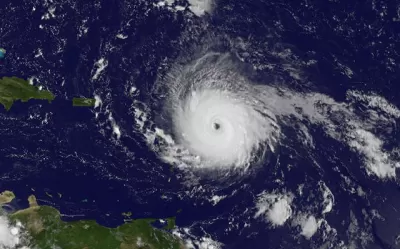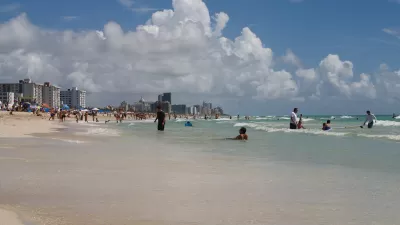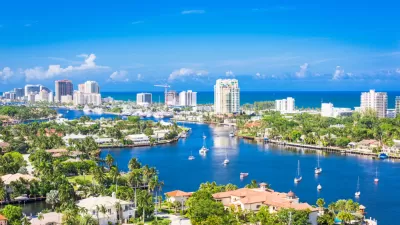As Irma leaves the Caribbean and heads for Florida, with landfall expected this weekend, there is a lot to worry about: New building codes will be put to test, fuel to evacuate is in short supply, and cranes have not been dismantled.

South Floridians are bracing for what is widely to expected the worst storm since the category 5 Hurricane Andrew hit 25 years ago. In fact, Gov. Rick Scott warned that it 'could be worse'. However, buildings are more prepared to weather the storm than they were in 1992, report Lizette Alvarez and Marc Santora for The New York Times.
After the storm, South Florida approved a building code intended to make structures better withstand high winds. The state came to be seen as an international leader in storm preparation.
"You'll see that buildings stand up better against hurricane-force winds," Bryan Koon, director of the Florida Division of Emergency Management, told ABC News.
But what of the buildings just going up now, and their construction cranes in particular?
"Like so much else in Miami, those cranes are marketed as hurricane-safe, but it turns out they're stable in winds of up to only 145 mph," reports Tim Elfrink for the Miami New Times. However, Irma's winds are being clocked at up to 185 mph.
Expect the cranes' arms to remain loose and spin (wildly?) in the wind as they can not be secured, according to Maurice Pons, deputy director of Miami's building department. Pons writes that he would "not advise staying in a building next to a construction crane during a major hurricane like Irma."
Fuel shortages hamper evacuations
"More than 650,000 people in Miami-Dade County are being told to leave, after Miami Mayor Carlos Gimenez expanded the mandatory evacuation zone further inland along the southeast Florida coast—although many were expected to stay behind to try to protect their homes," reports Phys.org. However, motorists have found many, if not most, gas stations closed.
Gov. Scott announced on Thursday that fuel shortages was his top concern He "ordered state highway patrol escorts for fuel trucks across the state, and at a noon news conference he urged gas stations to remain open as long as possible," reports The Washington Post. "He said police escorts will get gas station employees out safely if necessary before Irma arrives."
Besides the challenges of finding gas, Floridians are paying more at the pump this week. Fuel prices are up about 50 cents a gallon since Hurricane Harvey hit the Gulf Coast a week ago. However, some residents were reporting paying several dollars more per gallon than usual.
On Thursday, the national gasoline price average was $2.67 per gallon, according to AAA. That's 32 cents higher than Aug. 25, when Harvey made landfall. It was $2.73 in Florida. So much for the "nickel to 15 cents" increase that experts had predicted Harvey would cause.
Development patterns similar to Houston in some ways
"While most Florida cities have zoning rules more stringent than Houston’s, development is rampant" report Alvarez and Santora.
Since the end of the recession in mid-2009, many more buildings have risen on the coast and in other areas near water. Houses continue to spring from the wetlands of the Everglades. Mangroves, which act as filters and soil stabilizers, are disappearing. Sea level rise has exacerbated the dilemma.
Storm surge
"Hurricane Irma is anticipated to be a wind and storm surge rather than a rainstorm, which plays to South Florida’s strengths, forecasters said," add Alvarez and Santora. "A sudden change — like Houston’s 50 inches in rain — can upend the playbook."
"A storm surge of up to nine feet is possible along the southern Florida coast, with the risk worst in Collier County and southeastern Miami-Dade County, although the threat extends through northern Palm Beach County," reports David Fleshler for the Sun Sentinel. "Although this storm surge threat doesn’t approach the monstrous surges of up to 20 feet feared in some Caribbean islands, it could still cause substantial flooding and damage."
Caribbean and Texas hurricane death tolls
Irma left at least 13 people dead by Thursday in its path of destruction through the Caribbean. "Although Puerto Rico largely avoided the worst of Irma, with the highest wind gust on the Caribbean island measured at 70 mph, at least three people died there as a result of the storm's impact, according to the governor's office," reports ABC News.
As of Sept. 6, deaths from Hurricane Harvey amounted to 70, "a surprisingly low toll that experts say reflects heeded warnings, swift action by first responders and volunteers, and no small amount of luck," reports NBC 5 - KXAS.
"It was astounding that we didn't have a much larger loss of life," said Phil Bedient, co-director of a Rice University effort to research severe storms and evacuations. "It is a relatively low number for as big a storm as this was."
Last words go to Tim Elfrink, managing editor of the Miami New Times
The city's crane warning is just the most surprising reminder that Hurricane Irma could be an unprecedented test for Miami-Dade County. This is a vastly different city from the one that weathered Andrew in 1992. Let's hope all the new development is ready for what Irma might bring this weekend.
FULL STORY: After Andrew, Florida Changed Its Approach to Hurricanes

Study: Maui’s Plan to Convert Vacation Rentals to Long-Term Housing Could Cause Nearly $1 Billion Economic Loss
The plan would reduce visitor accommodation by 25% resulting in 1,900 jobs lost.

Alabama: Trump Terminates Settlements for Black Communities Harmed By Raw Sewage
Trump deemed the landmark civil rights agreement “illegal DEI and environmental justice policy.”

Why Should We Subsidize Public Transportation?
Many public transit agencies face financial stress due to rising costs, declining fare revenue, and declining subsidies. Transit advocates must provide a strong business case for increasing public transit funding.

Paris Bike Boom Leads to Steep Drop in Air Pollution
The French city’s air quality has improved dramatically in the past 20 years, coinciding with a growth in cycling.

Why Housing Costs More to Build in California Than in Texas
Hard costs like labor and materials combined with ‘soft’ costs such as permitting make building in the San Francisco Bay Area almost three times as costly as in Texas cities.

San Diego County Sees a Rise in Urban Coyotes
San Diego County experiences a rise in urban coyotes, as sightings become prevalent throughout its urban neighbourhoods and surrounding areas.
Urban Design for Planners 1: Software Tools
This six-course series explores essential urban design concepts using open source software and equips planners with the tools they need to participate fully in the urban design process.
Planning for Universal Design
Learn the tools for implementing Universal Design in planning regulations.
Smith Gee Studio
Alamo Area Metropolitan Planning Organization
City of Santa Clarita
Institute for Housing and Urban Development Studies (IHS)
City of Grandview
Harvard GSD Executive Education
Toledo-Lucas County Plan Commissions
Salt Lake City
NYU Wagner Graduate School of Public Service





























